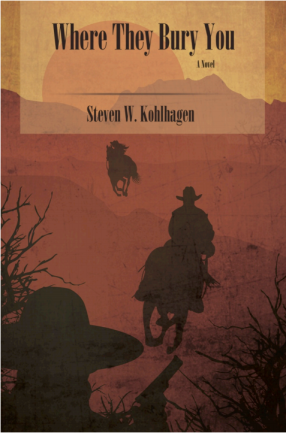
Steven W. Kohlhagen
Steven W. Kohlhagen has been kind enough to present us with some of the history that inspired his new book Where They Bury You:
On January 3, 1862, General Henry H. Sibley led his Texas Volunteers into the Arizona Territory to attack General Edward R.S. Canby’s Union Army, the Colorado Volunteers, and Colonel Kit Carson’s New Mexico Volunteers. His plans, blessed by President Jefferson Davis, were to take the Arizona, New Mexico, and Colorado Territories for the Confederacy, and then to march to California and conquer it as well.
The Civil War had come to the western Territories.
The Apaches and Navajo, previously fighting the Army, now found themselves almost back in time, raiding the Mexicans, the Utes, the New Mexican settlers, and each other now without any interference from the white soldiers. Cochise’s Chiricahua Apaches, tragically, had been at peace up until the year before. But a newly minted Lieutenant, George Bascom, blundered amateurishly into forcing the Chiricahuas back to war with the whites across the Arizona Territory.
Also at this time a group of con artists, with Canby’s own aide de camp, one Lieutenant Augustyn P. Damours, at its center, was in the process of embezzling tens of millions of today’s dollars from the Army, the Territorial Government, and the Church. Like the Indians, the local outbreak of the Civil War, presented the scam artists with new opportunities.
Sibley’s Rebels won both major battles in the Territories, at Valverde and at Glorieta Pass. But in the process, they left their supply train, stolen from the Yankees at Cubero, essentially unprotected. Major John M. Chivington of the Colorado Volunteers, more known for his infamous massacre of the Cheyenne people at Sand Creek two years later, stumbled onto the vulnerable train. By destroying it, he ended Sibley’s dreams of a Confederate West.
Canby elected to let the Texans retreat back to Texas, starving and harmless and unmolested, and then turned his attention back to the Apaches and the Navajo.
He assigned this task to Carson. Despite Carson’s continued attempts to retire, General James H. Carleton insisted on having him carry out Canby’s orders when Canby was reassigned to Washington, D.C. Carleton decided to have Carson move the Mescalero Apaches and Navajo to eastern New Mexico, to a desolate spot he called Bosque Redondo.
Canby unwittingly took Damours, the thieving aide de camp, with him to Washington. One month after they left Santa Fe, in the midst of Carleton and Carson’s Indian wars, Damours’ massive thefts came to light. In a bizarre twist, Carleton sent Major Joseph Cummings, also the Provost Marshal of Santa Fe, to apprehend Damours in Washington. Cummings was a known womanizer and gambler in the Territory, and, astonishingly, a gambling associate of Damours.
Not surprisingly, Cummings returned from Washington empty handed. Historians completely lost sight of Damours when he went AWOL from Canby’s office in the War Department on November 5, 1862.
Upon his return, Carleton and Carson then entrusted Cummings with part of the Army that was to hunt down and apprehend the 9,000 Navajo. On August 3, 1863 Carson put Cummings in charge of the scorched earth policy to try to bring in the Navajo who the Army was failing to even locate.
On August 18, 1863 Cummings was found dead in an arroyo from a lone bullet wound to his abdomen near Pueblos Colorado (near the site of today’s Hubbell Trading Post in Ganado, Arizona). He had $5,031.78 in cash and valuables in his saddle bags (between $700,000 and $1,000,000 of today’s dollars). Hampton Sides Blood and Thunder reports this on p. 341, as the “only” casualty of Carson’s Navajo campaign. Certainly an odd choice for the Navajo’s only killed soldier in their roundup.
Where They Bury You ends with that murder. But, of course, the Civil War and the Apache and Navajo Wars continued.
History always does.





